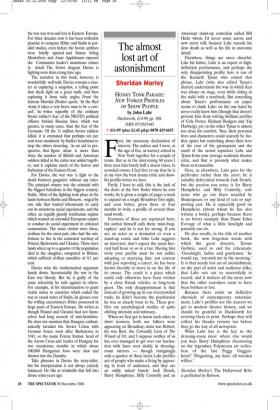The almost lost art of astonishment
Sheridan Morley
HONKY TONK PARADE: NEW YORKER PROFILES OF SHOW PEOPLE by John Lahr Duckworth, £14.99, pp. 308, ISBN 0715635441 ✆ £11.99 (plus £2.45 p&p) 0870 429 6655 First, the necessary declaration of interest. The author and I were, at the age of five, at nursery school in New York together for a couple of terms. But as in the intervening 60 years I have seen him barely half a dozen times, in crowded rooms, I feel free to say that he is in my view the best drama critic and showbiz profile-writer we have.
Partly, I have to add, this is the luck of the draw: at the New Yorker where he now works, he is given a couple of pages a week to expand on a single Broadway first night, and even better, given three or four months to write a profile of several thousand words.
Fourteen of these are reprinted here; the author himself calls them ‘mini-biographies’ and he is not far wrong. If you are an actor or a dramatist or even a stand-up comic and John Lahr suggests an interview, don’t expect the usual hurried half hour or so in a bar. Having him write your profile must be not unlike adopting or marrying him; not content with just reporting a career, he has been known literally to move in on the life of its owner. The result is a piece which could only otherwise have been written by a close friend, relative or long-term guest. The only disappointment is that instead of growing up in our overcrowded trade, he didn’t become the psychiatrist he was so clearly born to be. These profiles are psychological studies of quite chilling intensity and intimacy.
When we first got to know each other in short trousers, both our fathers were appearing on Broadway; mine was Robert, his was Bert, the Cowardly Lion of The Wizard of Oz; and I suppose neither of us has ever managed to get over our fascination with faces seen darkly in dressingroom mirrors — though intriguingly only a quarter of these latest Lahr profiles are of people who make a living by appearing in front of audiences, and they are an oddly mixed bunch: Judi Dench, Barry Humphries, Billy Connolly and an American stand-up comedian called Bill Hicks whom I’d never come across and now never will, because Lahr records his slow death as well as his life in awesome detail.
Elsewhere, things are more cheerful. Like his father, Lahr is an expert at highdefinition performance, and perhaps the only disappointing profile here is one of the Kenneth Tynan who coined that phrase. Lahr (who also edited Tynan’s diaries) understands the way in which Ken was always on stage, even while sitting in the stalls with a notebook. But something about Tynan’s performance on paper seems to elude Lahr: on the one hand he never really knew him (though that doesn’t prevent him from writing brilliant profiles of Cole Porter, Richard Rodgers and Yip Harburg), yet on the other Tynan is almost too close for comfort. True, their personal lives and characters could scarcely be further apart; but something about their love of the roar of the greasepaint and the smell of the crowd separates Lahr and Tynan from your average academic theatre critic, and that is precisely what makes them so treasurable.
Here, as elsewhere, Lahr goes for the performer rather than the actor: he is suitably deferential towards Judi Dench, but the passion you sense is for Barry Humphries and Billy Connolly, solo turns who go out there unaided by Shakespeare or any kind of text or supporting cast. He is especially good on Humphries (about whom he has also written a book), perhaps because there is no better example than Dame Edna Everage of what a little limelight and panstick can do.
He also recalls, in the title of another book, the now forgotten words with which the great director, Tyrone Guthrie, used to end his rehearsals: ‘Goodnight, ladies and gentlemen,’ he would say, ‘astonish me in the morning.’ It is that nearly lost art of astonishment, on the part of artist and audience alike, that Lahr sets out so successfully to record, and it matters all the more now that the other recorders seem to have been broken or lost.
Because there exists no definitive chronicle of contemporary entertainment, Lahr’s profiles are the nearest we get to modern theatre history, and we should be grateful to Duckworth for reviving them in print. Perhaps they will collect his theatre reviews too before they go the way of all newsprint.
What Lahr has is the key to the dressing-room door: where else would you hear Barry Humphries discoursing on the legendary Polynesian art collection of the late Peggy Guggenheim? ‘Disgusting, my dear: all wooden willies.’ Sheridan Morley’s The Hollywood Brits is published by Robson.




































 Previous page
Previous page